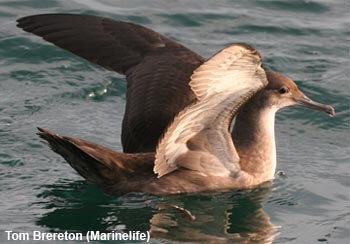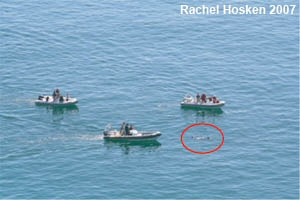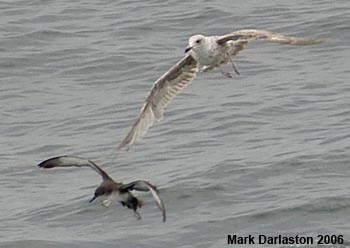|
SeaWatch SW - update |
|
|
|
The SeaWatch SW Project is an
exciting new initiative designed to collect important
information about some of the UK’s most threatened
marine animals, including Basking Sharks, Ocean Sunfish
and the critically endangered Balearic Shearwater. The
results will provide new insights into the occurrence
and behaviour of these species around our coasts, and
how we can protect them while they visit our waters. The
project is entirely volunteer-based, and is being
supported by a number of major conservation and
scientific organisations, including the National
Oceanography Centre, Southampton (NOCS), the Royal
Society for the Protection of Birds (RSPB) and the
Marine Conservation Society (MCS). |
|
|
|
The survey phase of the project will
be based at the Lands End peninsula in Cornwall from
mid-July to mid-October. During that period, we need
volunteer observers of any ability to assist with
observation and recording of target species. Further
details about how to get involved, latest sightings, and
the conservation and scientific background can be found
using the links above. If you have any enquiries, please
visit our
Contact Us page. |
|
|
|
|
|
Latest News |
|
|
|
Get involved in SeaWatch SW!
SeaWatch SW is largely based on the efforts of volunteer
observers, who will be based at the project watchpoint
at Gwennap Head between mid-July and mid-October. The
project has generated significant interest and all core
seabird observer slots are now full, ensuring continuous
‘dawn-to-dusk’ coverage by experienced observers for the
whole three months! In addition, we have just six days
of core shark observer slots remaining to be filled, so
if you would like to help out for a few hours or even a
day or two
click here for more information. |
|
|
|
Send us your UK Balearic Shearwater sightings now!
One of the main aims of SeaWatch SW is to provide a
central point for Balearic Shearwater recording in UK
waters; this will allow us to put project results into a
national context. We therefore urge anyone who sees a
Balearic Shearwater in the UK in 2007 to contact us with
details of the sighting. We have already received 125
records up the end of June, and are grateful to all
observers who have submitted their sightings. |
|
|
NEW SeaWatch SW survey begins on 15 July!
 At the time of writing, last-minute preparations are
under way for the start of the SeaWatch SW survey, which
will be based at Gwennap Head, Porthgwarra. The project
co-ordinator, Russell Wynn, will be manning the
watchpoint as core seabird observer for the first 16
days, from 15-31 July (this will be over 200 hours of
sea-watching!!). He then hands over to Ken Shaw who
watches until 6 August. The core shark observers are
students from the National Oceanography Centre (Rafe
Holmes, Leire Ordorika and Stephanie Hinder), who are
studying Basking Sharks, Ocean Sunfish and other marine
animals. We already have a couple of support observers
helping out during these first few days, and would
encourage anyone visiting the watchpoint to pop in and
have a chat! At the time of writing, last-minute preparations are
under way for the start of the SeaWatch SW survey, which
will be based at Gwennap Head, Porthgwarra. The project
co-ordinator, Russell Wynn, will be manning the
watchpoint as core seabird observer for the first 16
days, from 15-31 July (this will be over 200 hours of
sea-watching!!). He then hands over to Ken Shaw who
watches until 6 August. The core shark observers are
students from the National Oceanography Centre (Rafe
Holmes, Leire Ordorika and Stephanie Hinder), who are
studying Basking Sharks, Ocean Sunfish and other marine
animals. We already have a couple of support observers
helping out during these first few days, and would
encourage anyone visiting the watchpoint to pop in and
have a chat! |
|
|
NEW Balearic Shearwaters return to UK coastal waters
After an absence of a couple of months, the first
Balearic Shearwaters returned to UK coastal waters in
mid-May. Most of the 78 records through May and June
were of 1-3 birds seen passing watchpoints in southwest
England, although a notable flock of up to 50 birds
lingered off Portland Bill from mid-June onwards. To
view 2007 monthly summaries with distribution maps
click here. |
|
|
NEW Seabird new to Britain seen from SeaWatch SW
watchpoint!
On 25 May an experienced local sea-watcher was lucky
enough to see a Masked Booby passing the SeaWatch SW
watchpoint at Gwennap Head, Porthgwarra. What was almost
certainly the same bird had earlier been seen from a
boat off Dorset on 17 May and again from St Catherine’s
Point on the Isle of Wight on 19 May. This is the first
British record of this species. On a similar theme, an
immature Yellow-nosed Albatross, again a first British
record, was picked up exhausted at Brean Beach in
Somerset on 29 June. It was taken into care overnight
and successfully released at Brean Down the following
day. Further details and a link to a video clip of this
bird can be viewed
here. Intriguingly, other reports of Yellow-nosed
Albatross came from Norway and Sweden in late June and
early July, so who knows what else might turn up this
autumn? |
|
|
NEW Basking Shark harassment in SW waters
Large numbers of Basking Sharks were reported from
southwest England during May and early June, but
unfortunately there were also several reports of animals
being illegally harassed. Basking Sharks have been
protected under UK law since 1998, and it is illegal to
kill, injure or recklessly disturb them. Incidents such
as that photographed right in Cornwall this spring
should be reported to the police, together with any
photos or video that may help to identify the offending
boats or individuals. In addition, if you see a Basking
Shark this year, please submit your sighting to the MCS
Basking Shark Watch project
here |
|
|
NEW SeaWatch SW collaborates with Spanish partners
SeaWatch SW is teaming up with European partners to
better understand the dispersal pattern of Balearic
Shearwaters in Atlantic waters. The first step is to
share data with the team of observers who count birds as
they leave the Mediterranean via the Straits of
Gibraltar. Westward passage at this watchpoint showed a
marked peak in late May and early June; these early
departing birds will be non-breeding adults or immatures,
and will have contributed to the build-up in numbers off
southwest England from mid-June onwards. Further details
and latest results of seabird monitoring in the Straits
of Gibraltar can be found
here |
|
|
NEW SeaWatch SW attracts new grants and sponsors
SeaWatch SW would not be possible without the support of
a number of organisations. Grants that are being used to
pay for observer accommodation and equipment have been
received from RSPB (£1000), Royal Naval Bird-watching
Society (£500), SAHFOS (£500) and The Seabird Group
(£300). In addition, Birdguides are sponsoring the
project website, Southwest Optics are supplying
equipment, and data and logistical support have been
provided by the Marine Conservation Society, Cornwall
Bird-watching and Preservation Society and Cornwall
Wildlife Trust. A big thank you to all of them! |
|
|
NEW British Birds publishes important study on
Balearic Shearwaters
 A new paper by Russell Wynn and Pierre Yésou has just
been published in the July 2007 issue of British Birds,
entitled ‘The changing status of the Balearic Shearwater
(Puffinus mauretanicus) in northwest European waters’.
Abstract: Sightings data collated from across the
European Atlantic coastline reveal a recent change in
the post-breeding distribution of the critically
endangered Balearic Shearwater Puffinus mauretanicus,
with evidence for a progressive northwards shift in
dispersal patterns. Numbers recorded in the traditional
post-breeding quarters, centred on the French Biscay
coast, have declined since the mid-1990s and now show
marked inter-annual variability. In contrast, numbers
recorded from northwest European coastlines show a
dramatic and sustained increase since the mid-1990s,
with the majority being seen along the coasts of
northern France and southwest UK, and smaller numbers
north to southern Scandinavia. Although variability in
observer effort may have contributed to the observed
increase, the spatial and temporal consistency of the
results indicates that the underlying control behind the
distribution shift is natural. The increased dispersal
range may be contributing to the observed low adult
survival rate, and may therefore be a factor in the
species apparent population decrease. The results
presented here highlight the need for future
effort-based surveys across the species non-breeding
range, and will provide a baseline for conservation
measures in northwest European coastal regions where
large concentrations now regularly occur A new paper by Russell Wynn and Pierre Yésou has just
been published in the July 2007 issue of British Birds,
entitled ‘The changing status of the Balearic Shearwater
(Puffinus mauretanicus) in northwest European waters’.
Abstract: Sightings data collated from across the
European Atlantic coastline reveal a recent change in
the post-breeding distribution of the critically
endangered Balearic Shearwater Puffinus mauretanicus,
with evidence for a progressive northwards shift in
dispersal patterns. Numbers recorded in the traditional
post-breeding quarters, centred on the French Biscay
coast, have declined since the mid-1990s and now show
marked inter-annual variability. In contrast, numbers
recorded from northwest European coastlines show a
dramatic and sustained increase since the mid-1990s,
with the majority being seen along the coasts of
northern France and southwest UK, and smaller numbers
north to southern Scandinavia. Although variability in
observer effort may have contributed to the observed
increase, the spatial and temporal consistency of the
results indicates that the underlying control behind the
distribution shift is natural. The increased dispersal
range may be contributing to the observed low adult
survival rate, and may therefore be a factor in the
species apparent population decrease. The results
presented here highlight the need for future
effort-based surveys across the species non-breeding
range, and will provide a baseline for conservation
measures in northwest European coastal regions where
large concentrations now regularly occur |
|
|
NEW Boat-based Balearic Shearwater surveys begin in
Dorset and Devon
RSPB and Marinelife are leading a boat-based survey of
Balearic Shearwaters off southwest coasts this summer
and autumn. The aim is to record interactions between
Balearic Shearwaters and fishing boats, by placing
volunteer observers on the boats themselves. Sightings
made during the first survey in Weymouth/Lyme Bay on
July 8th included 41 Balearic Shearwaters and a good
selection of other seabirds. Full details and some nice
photos can be found
here. Anyone wanting to get involved in these
surveys should contact
Tom
Brereton |
|
|
|
|
|
Back |
|
|
|